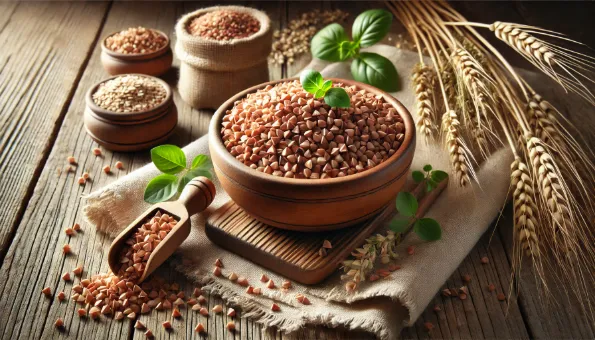Buckwheat Groats: Gluten-Free Pseudocereal Rich in Rutin, Fiber, Quality Plant Protein & Minerals
Whole hulled (or toasted ‘kasha’) buckwheat groats deliver complex carbs, fiber, ~13 g protein, magnesium, manganese, copper and antioxidant flavonoids (rutin, quercetin) with a naturally nutty, earthy taste.

What Are Buckwheat Groats?
Buckwheat groats are the **dehulled seeds of *Fagopyrum esculentum***—a broadleaf pseudocereal (not a true wheat, naturally **gluten-free**). Untoasted groats are pale green/ivory with mild grassy-nutty flavor; toasted groats (kasha) are darker brown, aromatic and cook faster. Forms: whole groats, cracked groats, flakes and flour.
Nutrition (per 100 g dry groats)
| | Amount | %DV |
|---|---|---|
| Calories | 343 kcal | — |
| **Protein** | 12.5–13.5 g | 25 % |
| **Carbohydrate** | 71–72 g | 26 % |
| – Fiber | 10 g | 36 % |
| Fat | 3.0 g | 4 % |
| **Magnesium** | 230 mg | 55 % |
| **Manganese** | 1.3–1.5 mg | 55–65 % |
| **Copper** | 1.0 mg | 110 % |
| **Iron** | 2.0 mg | 11 % |
| **Zinc** | 2.4 mg | 22 % |
| **Folate (B9)** | 30–35 µg | 8 % |
Rich in **rutin, quercetin, D-chiro-inositol** (insulin signaling research), and resistant starch when cooled after cooking.
Potential Benefits
- **Gluten-free complex carbohydrate** option supporting energy with slower digestion than many refined grains.
- **Higher lysine** than wheat (still benefits from pairing with legumes to optimize full amino acid profile).
- **Flavonoids (rutin, quercetin)** show antioxidant & vascular-supportive properties (rutin studied for capillary integrity).
- **Mineral density:** magnesium (muscle, glucose control), manganese (metalloenzymes), copper (iron metabolism), zinc.
- **Fiber + resistant starch (after cooling)** may aid glycemic moderation and gut fermentation.
- Toasted kasha provides deep flavor that can reduce added sodium/fats for palatability.
Drawbacks & Precautions
- **Allergy potential:** Rare buckwheat allergy (more noted in East Asia); can be severe—label clearly in mixed products.
- **Strong toasted flavor** may overpower delicate dishes—blend with mellower grains if desired.
- Naturally **moderate phytic acid** can reduce mineral bioavailability; soaking/toasting mitigates somewhat.
- Overcooking whole groats can become mushy/sticky; requires precise water ratio.
- Buckwheat flour in large proportion can yield **denser baked goods**; balance with starches or other flours.
Culinary Uses
- **Pilafs & grain bowls:** Combine with mushrooms, caramelized onions, herbs.
- **Breakfast porridge:** Simmer groats or cracked groats in water/milk; finish with fruit & nuts.
- **Salads:** Cook, cool and fold into tabbouleh-style salads or roasted vegetable mixes.
- **Noodles:** Milled into flour for **soba** (often blended with wheat for elasticity—pure 100% buckwheat soba is gluten-free but brittle).
- **Baking:** Pancakes, galettes (crêpes bretonnes), quick breads, crackers.
- **Kasha varnishkes:** Toasted groats with bowtie pasta & onions (contains gluten from pasta—adapt with GF pasta if needed).
Preparation & Technique
- **Rinse** raw groats to remove dust & slight bitterness; drain well.
- For fluffier texture: **dry toast** in skillet (if not pre-toasted) until aromatic before adding liquid.
- Typical **water:groats ratio**: 2:1 (raw) or 1.75:1 (lightly toasted). Simmer covered 12–15 min; rest 5 min, fluff.
- For porridge: 3:1 liquid & stir occasionally.
- **Soaking (1–2 h)** shortens cook time, can reduce phytic acid; drain & reduce cooking water slightly.
- Cool cooked groats (≥12 h chilled) to increase resistant starch for salads.
Health Context
- Relevant for **gluten-free diets & celiac** as a whole-grain-like staple (ensure no cross-contact in processing).
- **Magnesium + fiber** combination supports cardiometabolic dietary patterns.
- **Moderate glycemic index**; pairing with protein/fat further stabilizes postprandial response.
- Portion (cooked): **½–1 cup** depending on energy needs within balanced plate.
- Cooling/reheating maintains some resistant starch (beneficial fermentable substrate).
Sustainability Notes
Buckwheat is a **fast-growing cover crop**: suppresses weeds, supports pollinators (nectar-rich flowers) and thrives on marginal soils with low fertilizer needs. Integrating buckwheat into rotations improves soil structure & biodiversity. Choosing regional/organic sources supports low-input agriculture.
Storage
Store dry groats **airtight, cool & dark** up to 12 months. Whole groats have low oil content but can go rancid if warm/humid (nutty → bitter). Refrigerate buckwheat flour (higher surface area) for freshness. Cooked groats: refrigerate 4–5 days or freeze (flat) up to 3 months.
Key Takeaways
✔︎ Nutrient-dense gluten-free pseudocereal (fiber, magnesium, rutin)
✔︎ Versatile in savory & sweet dishes; supports soil health as cover crop
✖︎ Possible allergen & strong flavor when toasted—prepare & portion mindfully.
- 1. Buckwheat Groats
Used for its nutty flavor and nutritional benefits

